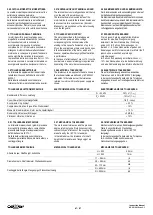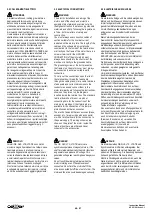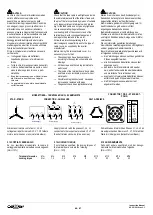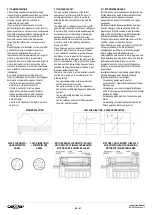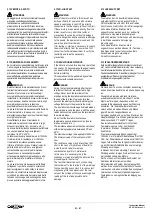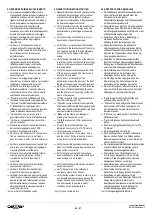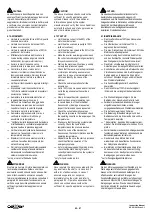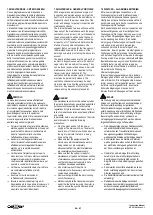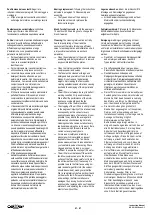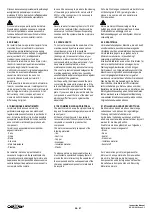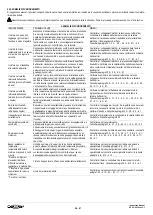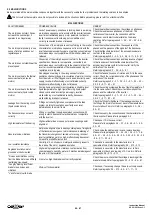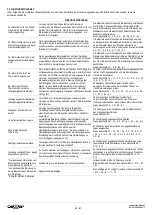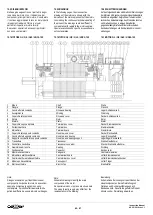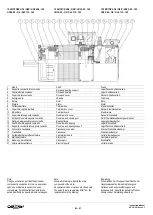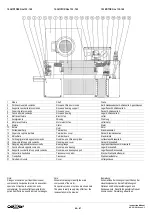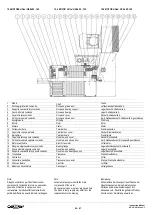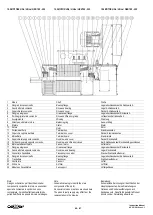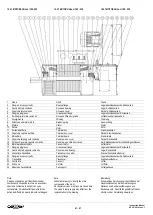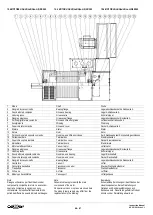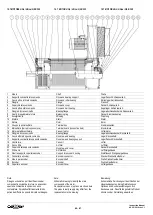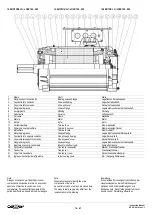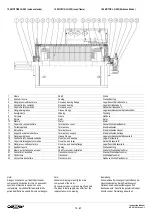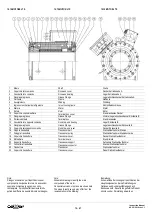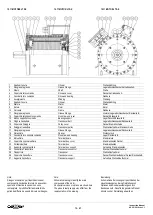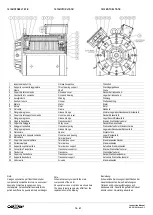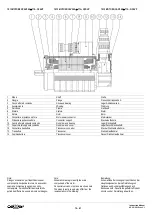
60 - 97
Instruction Manual
AC 02/2019-rev.1.1
9.0 MALFUNCTIONS
Below are listed all the main machine components together with the causes of possible faults or problems and the relating solutions to be adopted.
This list could not be complete since it is not possible to include all the situations. Before proceeding, please refer to our technical office.
MALFUNCTIONS
FAULT/PROBLEM
PROBABLE CAUSE
REMEDY
The motor does not start, it does
not reach the nominal rpm, it
operates in an irregular way
Lack of power supply, one phase is lacking, break in a winding,
motor phase sequence not in accord with the inverter/encoder,
inverter not calibrated properly, motor parameter not input or
faulty, transducer not functioning, not compatible or not
correctly connected, brake not released.
Check the electrical connections, the voltage on all phases,
Check the resistance on all phases of the motor. The
calibrations of the inverter, the connection with the
transducer and its electric characteristics, the brake
operation. Refer to paragraphs 5.1 - 5.2
–
5.3
–
5.5 - 5.9
–
5.11 - 6.0
The motor operates slowly in one
sense of rotation and does not
regulate speed
Connections of the motor phases not conforming to the inverter
characteristics, motor phase sequence not in accord with the
inverter/encoder encoder/resolver not working, connected in an
anomalous way or not compatible with the inverter, brake not
released
Check the electrical connections, the sequence of the
phases and the presence of the signals of the transducer.
Check that the characteristics of the encoder/resolver are
conform to the inverter.
Refer to paragraphs 5.2
–
5.3
–
5.5 - 5.9
–
5.11
–
6.0
–
6.1
The motor does not stabilize at the
preset speed
Connection of the motor phases not conform to the inverter
specifications, transducer not operative, connected in an
anomalous way or not conforming to the characteristics of the
inverter, incorrect parameters of the inverter, speed ring not
regulated, incorrect gains.
Check the electrical connections and the presence of signal
in the transducer. Check that the characteristics of the
encoder/resolver are conform to the inverter. Verify the
calibration of the inverter.
Refer to paragraphs 5.2
–
5.5
–
6.0
–
6.1
The motor overheats, the thermal
sensors activate (air cooled
motors)
Fan stopped or working in the wrong sense of rotation,
ventilation channels clogged, re-circulation of warm air coming
from the motor, air filter clogged, overloaded, incorrect power
supply, inverter malfunctioning or not calibrated correctly,
transducer malfunctioning, brake not released
Check the fan and its sense of rotation and, if it is the case,
correct. Check the current absorption of the phases and the
calibration of the inverter.
Refer to paragraphs 3.0
–
3.1
–
3.2
–
3.3
–
5.1
–
5.2
–
5.3
–
5.5 - 5.9
–
5.11
–
6.0
–
6.1
The motor overheats, the thermal
sensors activate (liquid cooled
motors)
Cooling liquid not present or not circulating, air bubble, inout
liquid temperature too high, liquid filter clog, liquid output
closed, overloaded, incorrect power supply, inverter
malfunctioning or not calibrated correctly, transducer
malfunctioning, brake not released
Check the cooling system and the input liquid temperature, if
it is the case, correct. Check the current absorption of the
phases and the calibration of the inverter.
Refer to paragraphs 3.0
–
3.1
–
3.2
–
3.3
–
5.1
–
5.2
–
5.3
–
5.5 - 5.7
–
5.11
–
6.0
–
6.1
Leakage from the cooling circuit
(liquid cooled motors)
Fittings not correctly tightened, overpressure in the feed
system, motor not mounted on a perfectly even level,
deformation on the motor frame
Check the fittings for tightness. If the leakage is not due to
the fittings, the motor must be sent back to the manufacturer.
Do not start such a motor. Refer to paragraphs: 3.3
–
3.8
–
6.0
–
6.1
The transducer does not work
correctly
Wrong or insufficient supply, anomalous connections with
wrong contacts, transducer’s electrical data not compatible
with the inverter.
Check the supply, the connections and the characteristics of
the transducer. Please refer to paragraph 5-2
High temperature of the bearing
High axial/radial load or speed, not precise coupling and/or
alignment
Check and, if it is the case, correct.
Please refer to paragraphs 3.6
–
3.7
–
3.8 - 4.0
–
4.1
–
4.2
–
4.3
–
5.0
Abnormal noise, vibrations
Not precise alignment, worn bearings, stale grease, fixing bolts
of the transmission organs or motor slackened, balancing of
the transmission organs not carried out or wrong, incorrect
inverter calibration, gain too high, malfunctioning transducer.
Screech from shaft currents brush
Check, solve the problem and, in case, replace bearings.
Please refer to paragraphs 3.0
–
3.4 - 3.5
–
3.6
–
3.7
–
3.8 -
4.0
–
4.1
–
4.2
–
4.3
–
4.4
–
4.5
–
5.0
–
5.0.4
–
5.2 - 5.3
–
5.5
- 5.9
–
5.11
–
6.0
–
6.1
Low insulation resistance
Humidity, dirt, oil, oil vapors, metal parts and dust present in
the inside of the motor, degraded insulation
Check and in case refer to the manufacturer or to
specialized firms. Refer to paragraphs: 5.9
–
5.12
–
5.13
Degraded insulation, motor
grounded or short circuited
High winding temperature, vibrations, contamination from
chemical agents, humidity, water, dirt, mechanical damages of
the wire or of the insulation
Check and in case refer to the manufacturer or to firms
specialized in Check and rewiring of A.C. motors. Refer to
paragraphs: 5.9
–
5.12
–
5.13
* Noises and vibrations coming
from the brake motor has difficulty
in attaining max. speed.
Aircore too high, the brake is not cerrectly supplied.
Check the aircore, check that the voltage is reaching all the
brake terminals. Refer to paragraphs: 5.3
–
5.12
–
6.0
–
6.1
* Lengthy braking, insufficient
brake torque, noises and
vibrations.
Worn-out friction material.
Check and, if necessary, change the worn-out components.
Refer to paragraphs: 5.3
–
5.12
–
6.0
–
6.1
–
11
–
13
* Valid for motors with brake


